Summary of October itinerary in Japan (Hokuriku / Kinki trip)
In Hokuriku (Ishikawa / Fukui) and Kinki (Kyoto / Hyogo), where I traveled from October 20th to October 27th as best itinerary in Japan, seasonal seafood and local dishes were very delicious and I was very satisfied with the trip. I was also able to visit many wonderful tourist destinations such as World Heritage Sites and National Treasure Buildings. Here is a summary of this trip and some notes.
Table of contents
2. Seasonal “PRIDE FISH” that I was able to eat on this itinerary in Japan
3. The biggest precautions for itinerary in Japan
5. October 20 (Wednesday) Ishikawa Prefecture Day 1
6. October 21 (Thursday) Ishikawa Prefecture Day 2
7. October 22 (Friday) Fukui Prefecture Day 1
8. October 23 (Saturday) Fukui Prefecture Day 2
9. October 24 (Sunday) Fukui Prefecture Day 3
10. October 25 (Monday) Kyoto Prefecture Day 1
11. October 26 (Tuesday) Hyogo Prefecture Day 1
12. October 27 (Wednesday) Hyogo Prefecture Day 2
I would like to reconfirm that, following the September itinerary, this October itinerary was created with the purpose of “eating out seasonal seafood and local dishes.” Food is the highest priority, and tourist destinations are the second priority. This is the so-called “Bread is better than the songs of birds” travel route. However, we aimed to visit as many tourist spots as possible, such as World Heritage Sites, National Treasures, and National Important Cultural Properties. It’s a hectic itinerary. Those who want to travel slowly will need to extend their itinerary or reduce the number of tourist attractions they visit. Personally, I recommend you to travel slowly with plenty of time.
1. “100 selections of local dishes” and “Local dishes loved by the nation” that I was able to eat on this itinerary in Japan
Ishikawa Prefecture : Jibu-ni
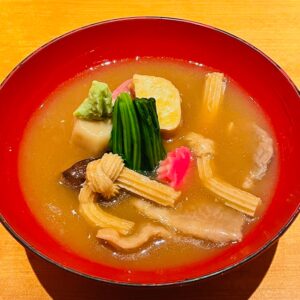
Fukui Prefecture : Echizen oroshi soba, Saba (mackerel) no heshiko
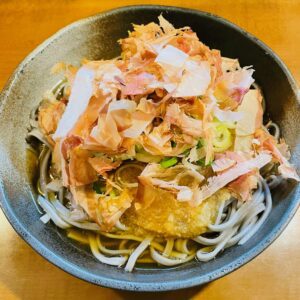
Hyogo Prefecture : Akashiyaki

“100 selections of local dishes” and “Local dishes loved by the nation” are selected by the Ministry of Agriculture, Forestry and Fisheries.
2. Seasonal “PRIDE FISH” that I was able to eat on this itinerary in Japan
Ishikawa Prefecture: Spanish mackerel, blackthroat seaperch, northern shrimp
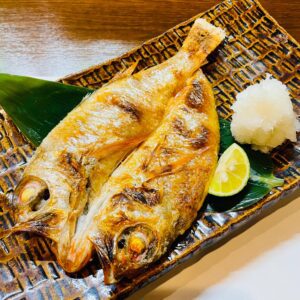
Fukui Prefecture: Spanish mackerel, Japanese amberjack
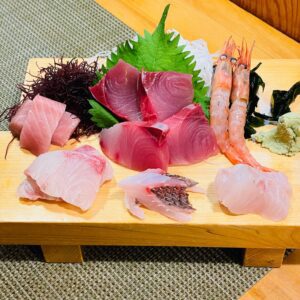
Kyoto Prefecture: Spanish mackerel
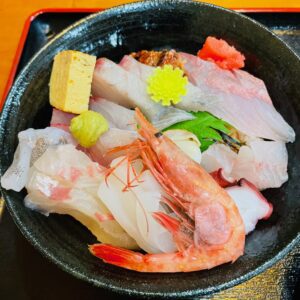
Hyogo Prefecture: Octopus, raw whitebait, Spanish mackerel, red sea bream
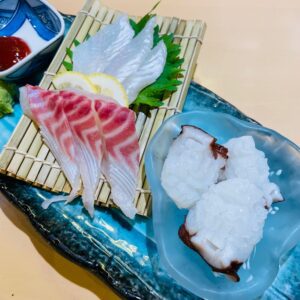
“PRIDE FISH” is selected by Japan Fisheries Cooperatives.
3. The biggest precautions for itinerary in Japan
This time, as a rule of travel, we have made it an environment-friendly trip that uses only public transportation including rental bicycles.
Again, traveling by public transport emits far less CO2 than traveling by car. For example, according to data from the Ministry of Land, Infrastructure, Transport and Tourism, CO2 emissions when one person travels 1 km are 130 g for automobiles, 98 g for aircraft (75% for automobiles), 57 g for buses (44% for automobiles), and 17 g for railways. 13%).
Since it is very difficult to understand how to get on and off the one-man train, here are some points to note regarding the use of local trains and buses, as we did last time.
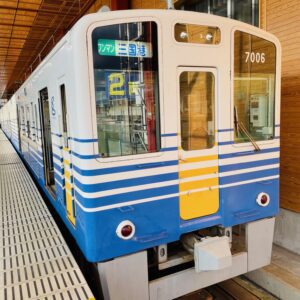
This time, there was a one-man train operated by the driver alone on the Echizen Railway. On this one-man train, like JR, you had to press the boarding / alighting button yourself to open and close the door when getting on and off. In the case of an unmanned station, you need to get a numbered ticket from the front door of the first car, and when you get off, you need to give the ticket to the driver in front of you to get off. Therefore, in the case of a one-man train, it is safe to always get on the front part of the first car. Be sure to remember the train boarding / alighting rules when traveling in rural areas of Japan. At Echizen Railway, posters on how to get on and off were posted at the station in Japanese, but there were no posters in foreign languages such as English.
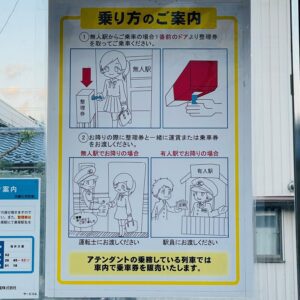
Also, when traveling long distances, the connecting time at the station may be long, so you will want to get off the train at that time. At local stations, there are often no coffee shops or other rest facilities, so if you don’t get off the train, you’ll have to spend time at an empty station. At that time, be sure to tell the station staff “I will leave the station once, but I will return to the next train”, then show the ticket and exit the ticket gate. As for Japanese tickets, tickets up to 100km are basically invalid for getting off the train, so if you exit the automatic ticket gate at a station on the way, the ticket will be collected. However, if you talk to the station staff and then get out, there is often no problem with getting off the train.
Also, please see the detailed notes written on each travel day.
4. Luggage free trip
In this trip as well, I sent my clothes and power cord to the accommodation in advance and enjoyed the “luggage free trip” every day. For example, on the first day, I took an airport bus from Komatsu Airport to Komatsu Station, and I was able to get on a large construction machine at Komatsu no mori because I didn’t have a large luggage. I stayed in Kanazawa, so I couldn’t go to the hotel to leave my luggage. After all, it is very easy to travel in a light style like taking a walk. Being able to act immediately after arriving by train or plane is important for effective use of time. Again, on the last day of the trip, I sent the clothes I wore during the trip to the laundry agent and did not have to do the laundry. I want everyone to experience the comfort of “luggage free trip”.
5. October 20 (Wednesday) Ishikawa Prefecture Day 1
On the first day, I went to “Komatsu no Mori” and “Natadera temple“.
“Komatsu no mori” is a facility that was established on the site of the Komatsu Factory in 2011 to commemorate the 90th anniversary of the founding of Komatsu, a construction machinery manufacturer. You can enjoy it all for free.
At Komatsu no mori, it is attractive to be able to board the driver’s seat of the super-large dump truck “930E” and the super-large hydraulic excavator “PC4000”, which are the only ones in Japan. Both of them operate only in overseas mines, so in Japan you can only ride in Komatsu no mori.

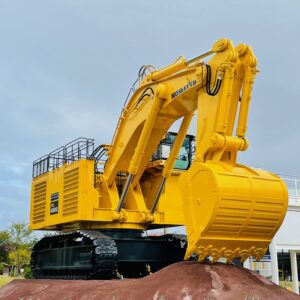
Natadera Temple’s Daihikaku (main shrine), three-storied pagoda, Goma-do, bell tower, and Shoin are national important cultural properties. In addition, Kigan Yusenkyo Rock and Inari Shrine, Shoin Garden and Tea Room are national scenic spots. I was particularly impressed with the splendor of Daihikaku (main shrine).
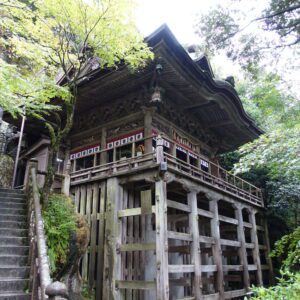
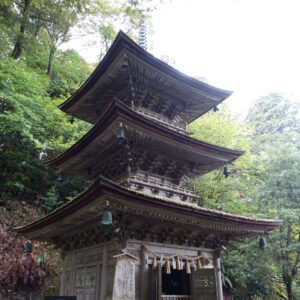
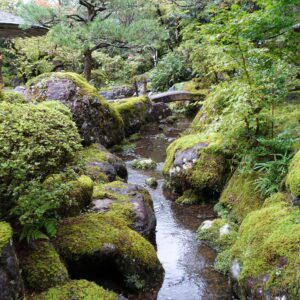
Meals
After visiting “Komatsu no mori”, I had lunch at “Kappo Sushi Yonehachi“, the oldest sushi restaurant in Komatsu City. The sushi is very delicious and the service is good, so it is a recommended sushi restaurant. This is one of the most memorable restaurants in this trip to Hokuriku and Kinki.
Many sushi restaurants in Kanazawa are so popular that it is difficult to make reservations due to the increase in tourists from Tokyo after the opening of the Hokuriku Shinkansen, and the prices are very high. You can enjoy delicious sushi at a reasonable price at “Kappo Sushi Yonehachi” in Komatsu City. The sushi course I ate this time was Yen 6,500, which was a great deal.
“Kappo Sushi Yonehachi” has a “Hinoki Stage (Noh Stage)” in Itaba. The sushi I had in front of the historic restaurant “Hinoki Stage” was exceptional.

Almost all of the sushi offered at “Kappo Sushi Yonehachi” uses seasonal seafood from the coastal waters. It was a store that perfectly matched the theme of our trip, “Eating seafood that is in season in October.” I was able to eat the Spanish mackerel and northern shrimp introduced in the seasonal fish of Ishikawa prefecture.

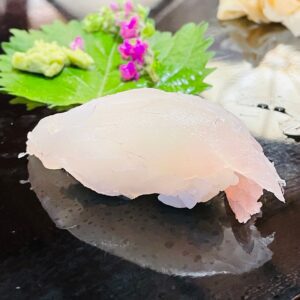
Important points
The dates and times for boarding both large construction machines at Komatsu no Mori are as follows. The open time is only 1-2 hours a day, so those who want to ride a large construction machine need to confirm the time in advance.
Event date
Every Tuesday-Saturday (excluding the 5th Saturday)
(April-November) 10: 00-11: 00/15: 00-16: 00
(December-March) 10: 00-10: 30 / 15: 00-15: 30
It will be canceled in bad weather.
Please note that there are only 5 buses a day from Natadera (for Awazu Station and Komatsu Station) on weekdays and 3 buses a day on Saturdays, Sundays, and holidays. The tour bus “Canvas” that goes around Kaga Onsenkyo was suspended until October 31, but it has been announced that the bus that also stops at Natadera Temple resumed operation from November 1. Canvas operates four times a day.
6. October 21 (Thursday) Ishikawa Prefecture Day 2
On the second day, I went sightseeing in Kanazawa. Sightseeing spots are compactly organized in Kanazawa, and each spot is within walking distance. Therefore, you can visit many tourist spots in one day.
The sightseeing spots I visited in Kanazawa are as follows. Former Ishikawa Prefectural Second Junior High School Main Building, Former Kanazawa Army Weapons Branch (Ishikawa Prefectural Museum of History , Kaga-Honda Museum), National Crafts Museum, Seisonkaku, Kenrokuen, Kanazawa Castle Park, Osaki Shrine, Oyama Shrine, Naga-machi Samurai Residence District, Kanazawa Station. 21st Century Museum of Contemporary Art, Kanazawa is also famous for sightseeing in Kanazawa. I have been there before, so I didn’t go this time, but I think it’s worth it if you’ve never been to a museum.
Former Ishikawa Prefectural Second Junior High School Main Building, Former Kanazawa Army Weapons Branch, Seisonkaku, Kanazawa Castle Park (Ishikawa-mon gate, Sanjukken Nagaya, Tsurumaru Storehouse), Osaki Shrine, Oyama Shrine (Shinmon gate) are national important cultural properties.
In addition, Kenrokuen is a national special place of scenic beauty.
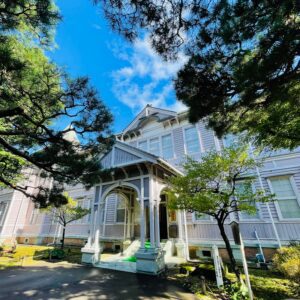
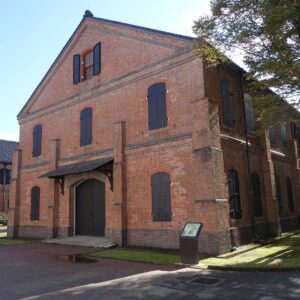
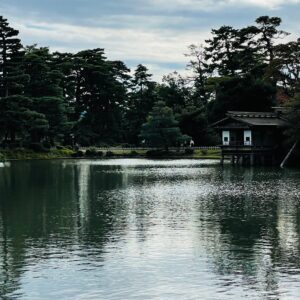

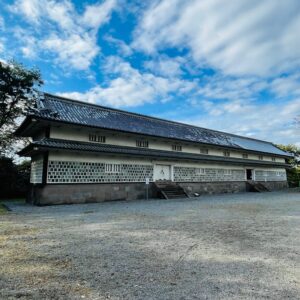

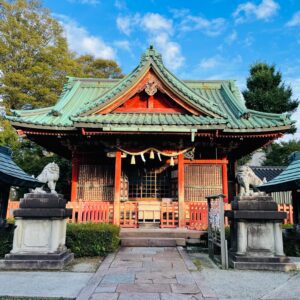

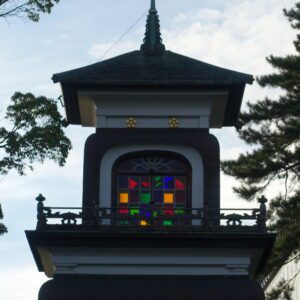
Meals
I had lunch at “Miyoshian” in Kenrokuen. I ate a tea kaiseki-style bento (Yen 3,300). Lunch while looking at the garden at Kenrokuen, a national special place of scenic beauty, was a luxurious experience. Also, I was very satisfied with the meal that included plenty of seasonal ingredients from Ishikawa prefecture.
The contents of the meal are konbu maki of spanish mackerel and northern shrimp sashimi (sashimi), which is a seasonal fish, Jibu-ni, which is a local dish of Ishikawa prefecture, and Koubako crab (however, it was from Niigata. fishing in Ishikawa prefecture start on November 6th), grilled Japanese amberjack, tempura of Kaga vegetables, etc. We highly recommend eating at “Miyoshian” in Kenrokuen.
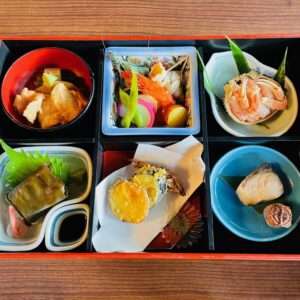

I also recommend “Yumeri” where I ate dinner. “Yumeri” is a restaurant that mainly serves local fish and sake from Oku Noto, the origin of the owner of the restaurant. Anyway, all the dishes were delicious. In particular, the assorted sashimi, grilled blackthroat seaperch, sashimi of Japanese babylon, and steamed lotus root of Kaga were the most delicious.
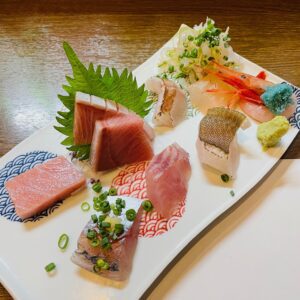

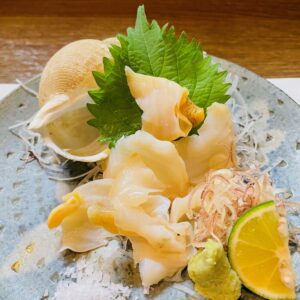
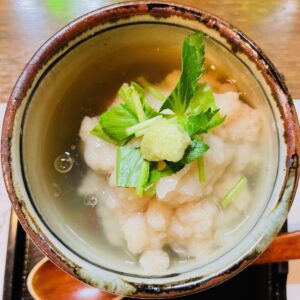
Important points
There are many great deals such as common tickets for sightseeing in Kanazawa. It’s a good idea to check in advance.
Kenrokuen Plus One ticket (valid for 2 days)
Adults (18 years old and over) Yen 500
In addition to Kenrokuen, you can enter any of the 6 facilities (Kanazawa Castle Park, Ishikawa Modern Literature Museum, Ishikawa Prefectural Museum of Art, Ishikawa Prefectural Museum of History , Kaga Honda Museum, Ishikawa Prefectural Museumof Traditional Arts and Crafts).
SAMURAI PASSPORT (valid for 2 days)
You can enter 12 facilities for Yen 1,000.
7. October 22 (Friday) Fukui Prefecture Day 1
On the third day, I headed from Ishikawa prefecture to Fukui prefecture and went to Maruoka Castle, Eiheiji Temple, and Ichijodani Asakura Ruins.
Maruoka Castle is a national important cultural property and one of the 12 existing castle towers.
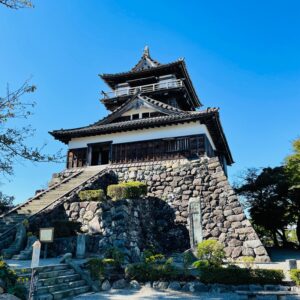
Eiheiji is a Buddhist temple of the Soto sect and is the central temple of the Japanese Soto sect (Daihonzan). 19 buildings such as the mountain gate, Buddhist temple, and temple are designated as national important cultural properties. There is a national treasure “Fukan Zazengi” written by the founder Dogen in the treasure hall of Eiheiji Temple.
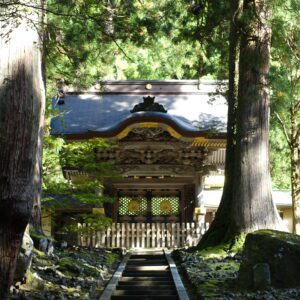
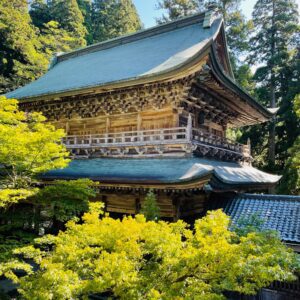
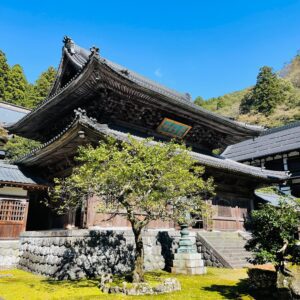
The Ichijodani Asakura Ruins are designated as a national special historic site, special scenic spot, and important cultural property. In addition to the Ichijodani Asakura Ruins, there are only five locations: Kinkakuji, Ginkakuji, Daigoji Sanboin, Heijo Palace, and Itsukushima Shrine.
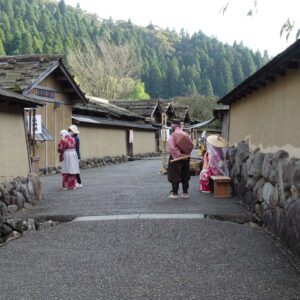
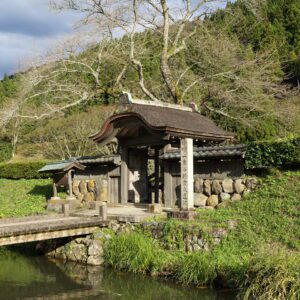
Meals
I had a supper at “Yoshijin”, which is about a 3-minute walk from Fukui Station. It is an excellent restaurant with many menus as well as seafood caught in the Sea of Japan. On this day, I ate assorted sashimi (yellowtail, Japanese amberjack, northern shrimp, great amberjack, Japanese sea bass, sea bream), fried Japanese glass shrimp, mozuku (cladosiphon okamuranus) vinegar, dadami (shirako, cod milt ) ponzu, heshiko-yaki, and Takeda Aburaage (deep‐fried tofu).

“Heshiko-yaki” was too salty for me. “Saba no Heshiko” is made by salting mackerel from which the internal organs have been removed and then pickling it in kasuzuke (preserved food in sake cake). It is eaten as it is or baked. “Saba no Heshiko” has been selected as one of the “100 Best Local Cuisine” in Fukui Prefecture by the Ministry of Agriculture, Forestry and Fisheries.
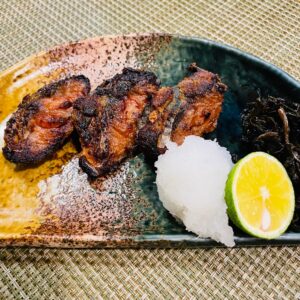
“Takeda Aburaage” is deep‐fried tofu from the long-established store Taniguchiya (founded in 1925) in Fukui prefecture. According to a household survey by the Ministry of Internal Affairs and Communications, Fukui City ranked first in terms of the amount of consumption per household (family of two or more) in 2020 for “Aburaage / Ganmodoki (fried bean curd cake with vegetables and other ingredients in it) “. The average consumption amount was 6,197 yen in Fukui City, which was more than double the national average of 3,027 yen.
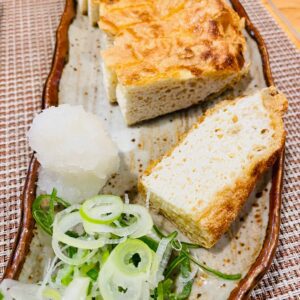
Important points
It takes 19 minutes by bus from Awara Onsen Station to Maruoka Castle, but 50 minutes from Fukui Station. Even if you go to Tojinbo, Awara Onsen Station is more convenient than Fukui Station because it is closer to Tojinbo. Limited to weekends and holidays, there is a one-day pass for Tojinbo, Awara Onsen, Awara Onsen Station, Maruoka Castle, and Eiheiji Temple.
You can freely ring the bell at “Jakkouen” in the back of Eiheiji Temple. Like the treasure hall, few people visit “Jakkouen”, but why not try ringing a bell at Eiheiji Temple, which has a solemn atmosphere.
8. October 23 (Saturday) Fukui Prefecture Day 2
On the 4th day of the trip, I went to Tojinbo, Takidanji Temple, Old Kishina Family Home, Former Morita Bank Head Office, Fukui Station, Daianji Temple, Yokokan Garden, and Sakaenoyashiro.
Tojinbo is a national scenic spot and a natural monument. Columnar joints continue for about 1 km. The steep rock wall is about 25m at the highest point.

Takidanji Temple is a national important cultural property and a scenic spot. Due to the leaking work of the treasure hall, it was not possible to see the national treasure, Kondo hosoge monkei (Gold and Bronze Treasure Soka Bianqing, Heian period 794-1185 ringer). You should be able to see the national treasure when the construction is completed.
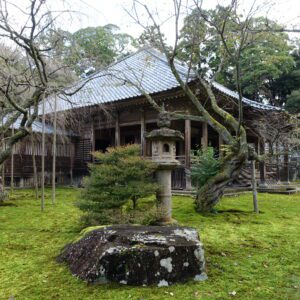
The main hall, mountain gate, and mausoleum of Daianzenji Temple are national important cultural properties.
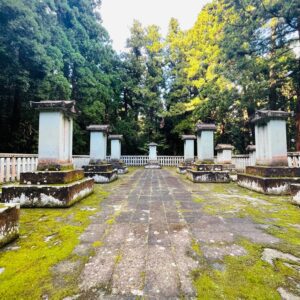
Yokokan Garden is a strolling garden with a sukiya-style mansion and is a national scenic spot.
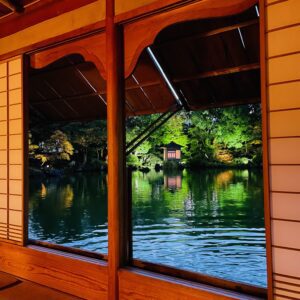
Around Fukui Station, you can enjoy dinosaur monuments, sitting dinosaur doctors, and dinosaur trick art.

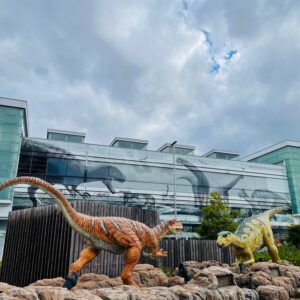
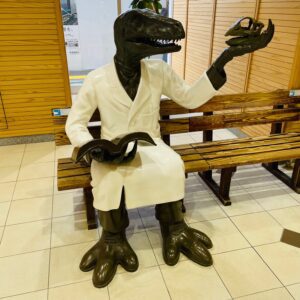
Meals
I had lunch at “Amidasoba Fukui” on the first floor of the building “Happiring” next to Fukui Station. Echizen oroshi soba from “Amidasoba Fukunoi” is a type of oroshi soba with grated radish in noodle soup. The Ministry of Agriculture, Forestry and Fisheries has selected Echizen oroshi soba as one of the “100 Best Local Cuisine” in Fukui Prefecture.
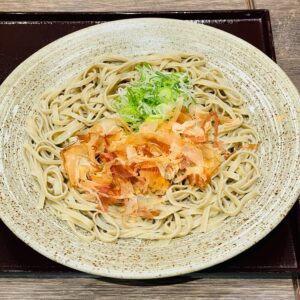
I had dinner at “Marusanya Fukui Katamachi”. Hamayaki mackerel, a local food from Fukui prefecture, was excellent.
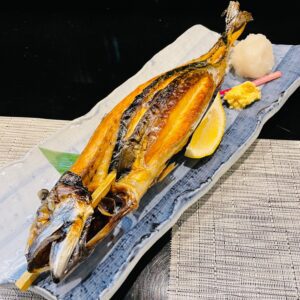
After “Marusanya Fukui Katamachi”, I ate grated soba (Yen 700) at “Tegaru Soba” nearby. The oroshi soba noodles from “Tegaru Soba” were so delicious that I thought they were the most delicious during this trip to Fukui. I like oroshi soba radish to be spicy, but the spiciness of “Tegaru Soba” was as spicy as I wanted.

Important points
Echizen Railway has a one-day free ticket only on Saturdays, Sundays, and holidays. All-you-can-ride for one day is Yen1,000 for adults (junior high school students and above) and Yen500 for children. The ticket from Fukui Station to Mikuniminato Station (the nearest station to Tojinbo) is Yen770 one way, so it’s a great deal if you make a round trip. In addition to Tojinbo, if you go to Fukui Prefectural Dinosaur Museum by Echizen Railway to Katsuyama Station (Yen770 one way), you can save even more.
9. October 24 (Sunday) Fukui Prefecture Day 3
On the 5th day, I visited the ruins of Imajoj-shuku Honjin, Tsuruga, Myotsuji, Jinguji, Wakasa Ichinomiya (Wakasahime Shrine), “Sotomo Tour” sightseeing boat, and Obama Nishigumi.
The site of Imajo-shuku Honjin is a post town used by the Fukui domain when they changed their attendance. It is designated as an important traditional buildings preservation district of the country.

The former Owada Bank head office main building in Tsuruga, Kehi Jingu Shrine Otorii are national important cultural properties.
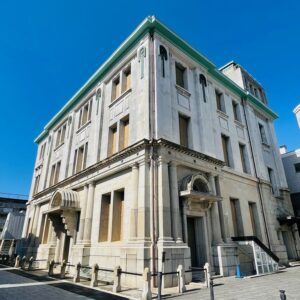
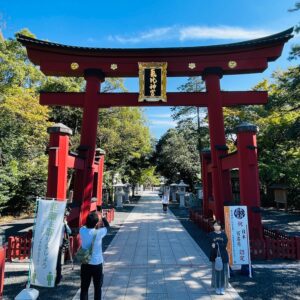
Myotsuji temple is the only national treasure building (main hall and three-storied pagoda) in Fukui prefecture. The main hall was rebuilt in 1258 (mid-Kamakura period), and the three-storied pagoda was rebuilt in 1270. The three-storied pagoda is the eighth oldest in Japan. Both the main hall and the three-storied pagoda were wonderful. There are also national important cultural properties, such as the statue of Yakushi Nyorai in the main hall. Most of them are from the Heian period (794-1185).
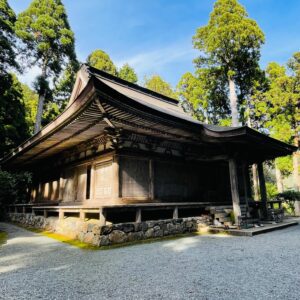
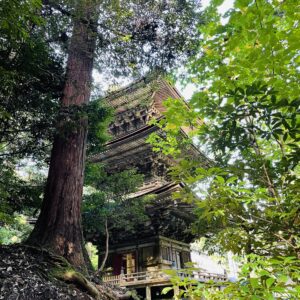
The main hall of Jingu-ji Temple, which is famous for “Omizuokuri”, is a national important cultural property.
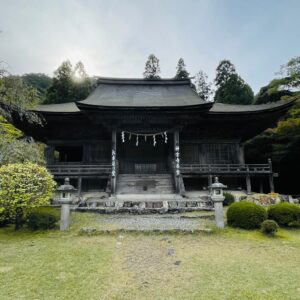
“Sotomo” is a national scenic spot.
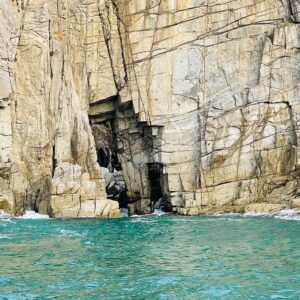
Obama Nishigumi is designated as an important traditional buildings preservation district of the country.

Meals
I had ekiben for breakfast. The ekiben is “Tsuruga specialty sea bream sushi” (Yen1,100). Beautifully colored sushi made with sea bream. It was very delicious sushi.
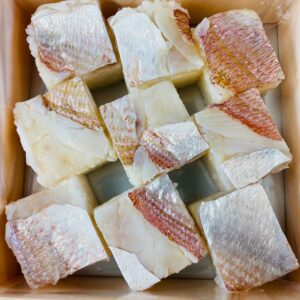
I had lunch at “Sushi Masa Main Store”. I ordered “3 kinds of specialties” (Yen 2,400). Contains 3 types of mackerel sushi, Kotai sushi, and grilled mackerel nigiri. We can eat two kinds of fish, which are Obama’s famous mackerel and yellowback seabream. Mackerel is a sushi that can be eaten in two ways.
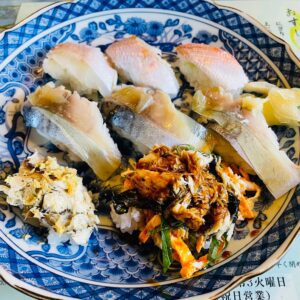
I had dinner at “Totogen Nishi Maizuru”. I was very satisfied with the dinner at “Totogen Nishi Maizuru”. I ordered luxury yakko tofu, sashimi (hairtail, horse mackerel, whitemouth Jack, spotted knifejaw), tempura of black small shrimp and Manganji-yaki.All the fish I received for sashimi were from the sea near Maizuru.
otukuri--300x300.jpg)
お造り-300x300.jpg)
Tsuchi shrimp (black small shrimp, soil shrimp) is a phantom shrimp caught in the sea near Tango, Kyoto. Shrimp are perishable and are not widely distributed except at landing sites. The black small shrimp tempura had a rich flavor and was surprisingly delicious.
土海老-300x300.jpg)
Manganji Togarashi is famous as a Kyoto vegetable.Since Maizuru originated, it was good to be able to eat delicious Manganji Togarashi in the birthplace.
万願寺-300x300.jpg)
Important points
The coin locker at Imajo station is free, so it’s great when you take a walk.
I rented an electrically power assisted bicycle at the tourist information center in front of Obama Station, and it took about 40 minutes (about 9km) to reach Myotsuji Temple. You can get to Myotsuji Temple from Obama Station by “Aiai Bus”, but there are only 4 buses a day.
I couldn’t go around the all Obama’s tourist spots in half a day, so I thought it would take at least one day.
10. October 25 (Monday) Kyoto Prefecture Day 1
On the 6th day, I visited Chionji Temple, Amanohashidate, and Ine Funaya.
Chionji Temple is known as one of the three Manjusri Bodhisattva temples in Japan. The Tahoto, which was completed in 1501, is a national important cultural property.
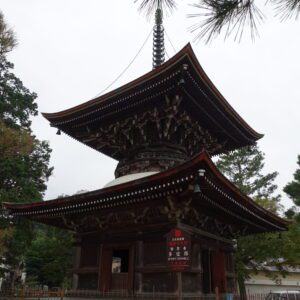
Amanohashidate is one of the three most scenic spots in Japan and is a national special place of scenic beauty. In addition, Amanohashidate cannot be seen beautifully unless it goes up to a high place.
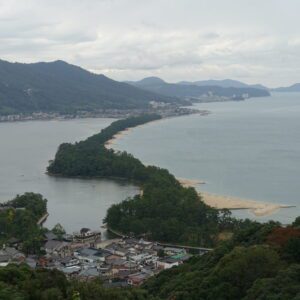
Ine has been designated as an important traditional buildings preservation district of the country by the Agency for Cultural Affairs. Ine Funaya is a building with a residence above the storage of the ship.
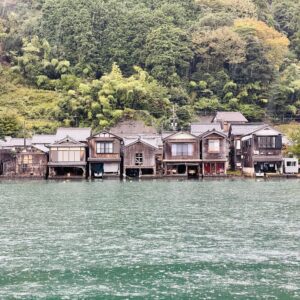
Meals
I had “Kaisen-don (seafood bowl) ” (Yen1,500) and “One Heshiko Sushi” (Yen200). The seafood bowl was delicious above average with lots of ingredients such as Spanish mackerel, red sea bream, gurnard, and great amberjack. Japan Fisheries Cooperatives has selected the Spanish mackerel (season: October-December) as the autumn “PRIDE FISH” in Kyoto Prefecture.
What impressed me was the “Heshiko sushi”. Mackerel heshiko is a local dish in Ine where many mackerels are caught like Fukui. For “Heshiko sushi” of “Hyoshiro”, remove the saltiness of “Heshiko” with vinegar etc. and put green onions and ginger on it.

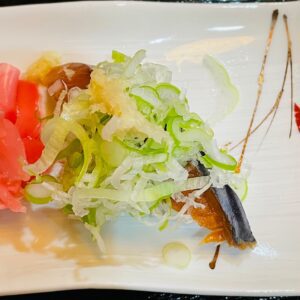
Important points
There is a free bicycle rental at the Ine Tourist Information.
On rainy days, it is recommended to visit the inside of the boat. The two boathouses were free to go around and cost Yen600 for adults and Yen300 for children.
Buses are often delayed from the timetable, so make sure you have plenty of time to transfer to the train.
11. October 26 (Tuesday) Hyogo Prefecture Day 1
On the 7th day, I visited Shoshazan Engyoji Temple, Himeji Castle, Koko-en Temple, Ichijoji Temple, and Kakurinji Temple.
Shoshazan Engyoji Temple is a special head temple of the Tendai sect. It is said that Shoku was founded in 966. The Dai-ko-do, Jiki-do and Jogyo-do are all national important cultural properties.
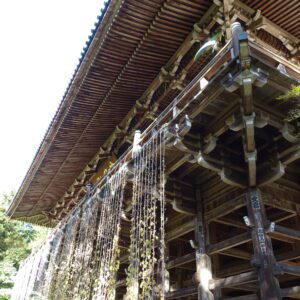
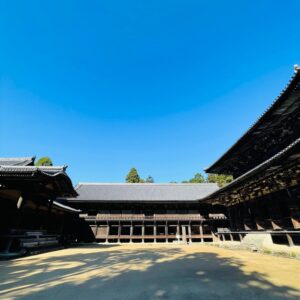

Himeji Castle, along with Horyuji Temple in Nara, became Japan’s first World Heritage Site. It is also a national treasure.
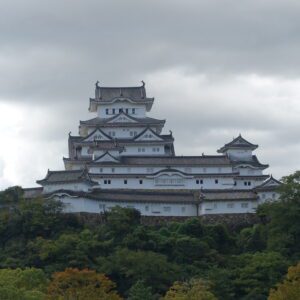
Ichijoji is a temple of the Tendai sect, which was founded in Kasai City, Hyogo Prefecture, in 650 AD. The three-storied pagoda, built in 1171, is a national treasure. It is the 6th oldest triple tower in Japan. The Daihikaku (main hall) and Jogyo-do, which are national important cultural properties, were also wonderful buildings.

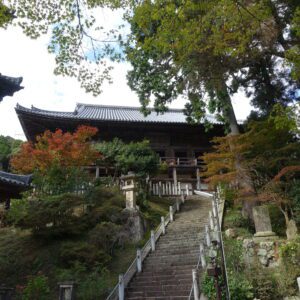
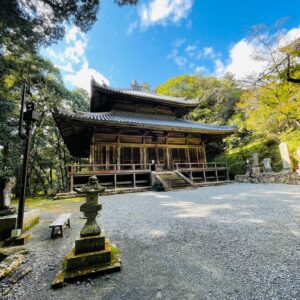
Kakurin-ji is a temple of the Tendai sect located in Kakogawa City, Hyogo Prefecture. It is said that the temple that Prince Shotoku ordered to build in 589 was the beginning of Kakurin-ji. The main hall and Taishido are national treasures. The bell tower, Jogyodo, and Gomado are national important cultural properties.
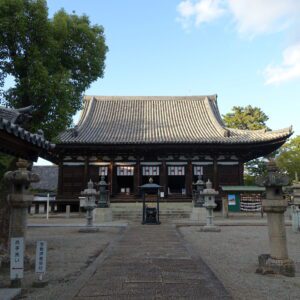
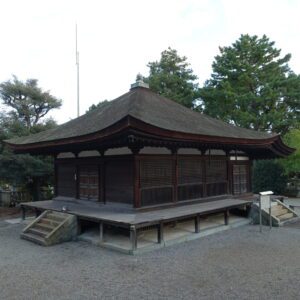
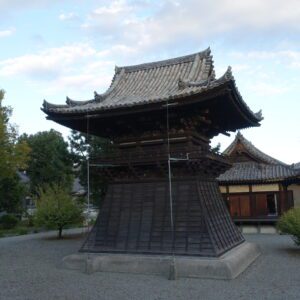
Meals
I had dinner at “Kaminari Sushi“. The owner is from a family of fishermen on Boze Island (Ieshima Islands) in Harima Nada (the Sea of Harima). “Kaminari Sushi” is procured from seafood such as Harima Nada, and is served at sushi restaurants.
I ordered “Kaminari Omakase” for Yen12,100. It was a great deal. I ate assorted sashimi (manti shrimp, Japanese tiger prawn, razor clam, Sakhalin surf clam), chawan-mushi, sushi (blackthroat seaperch, sardines, sea urchin and salmon roe, conger eels), Sazae no Tsuboyaki (Turbo cooked in its own shell), gazami crab, and grilled kinki (broadbanded thornyhead). In addition, the catch of mantis shrimp and conger eel is large in Himeji, and it is a specialty of Himeji.
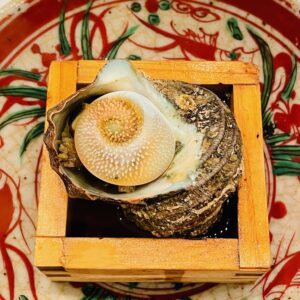
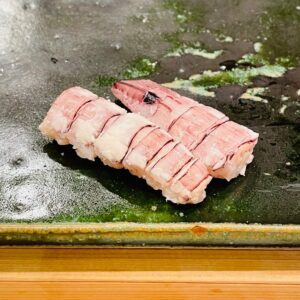
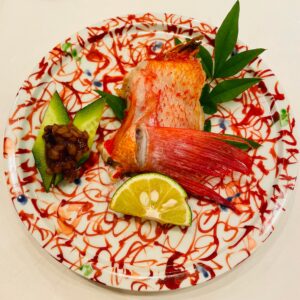
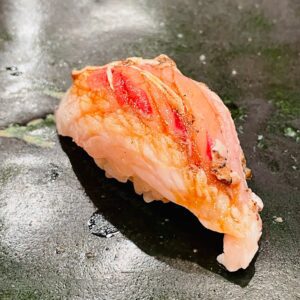
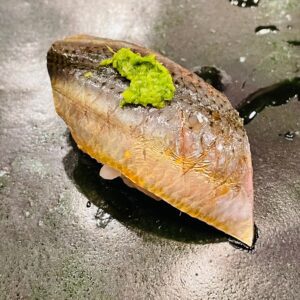
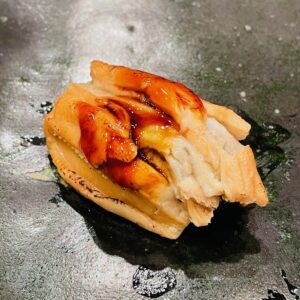
Important points
If you take a lot of buses, the one-day ticket for Shinki Bus (Yen1,300 for adults and Yen650 for children) is a great deal. There is also a set ticket for the Shoshazan Ropeway and bus from Himeji Station (adults Yen1,420, children Yen710).
You can see three national treasures in one day: Himeji City, Kasai City, and Kakogawa City. However, it can be quite busy, so it is recommended that you divide the tour into two days if possible.
12. October 27 (Wednesday) Hyogo Prefecture Day 2
On the 8th day, we visited Akashi Castle, Road Station “Awaji”, Awaji Yumebutai, Former Kinoshita House, Goshikizuka Tumulus, Former Sanji Muto Residence, Sun Yat-sen Memorial Hall, and Kobe Harborland.
The two triple turrets of Akashi Castle are national important cultural properties. The two turrets of Akashi Castle are valuable, as are two of the three turrets that only exist in Japan.
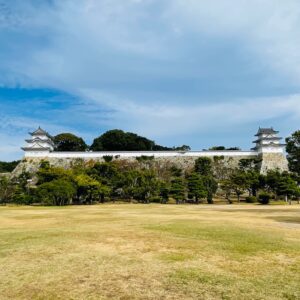
The Goshikizuka Tumulus is a “keyhole‐shaped” tumulus (total length 194 m, rear circle height 18 m) built from the end of the 4th century to the beginning of the 5th century. From the top of the tumulus, you can clearly see Awaji Island, Akashi Kaikyo Bridge, and Osaka Bay, which is a wonderful view. It is a tourist spot that many people recommend to visit.
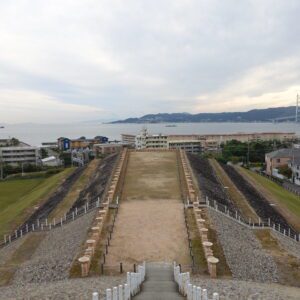
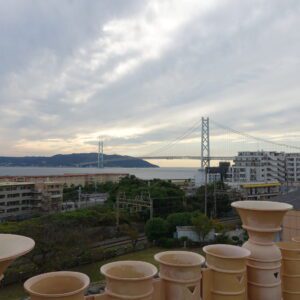
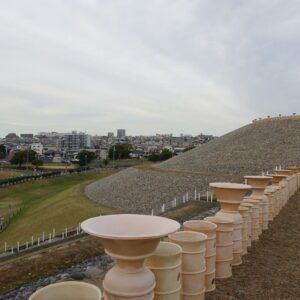
The Sun Yat-sen Memorial Hall is an octagonal three-story tower called “Ijokaku” and is a villa built by Kobe trader Jintang Wu in 1915 (Taisho 4). Currently, as the Sun Yat-sen Memorial Hall, materials such as the relationship between Kobe and Sun Yat-sen are exhibited. It is a national important cultural property.

Meals
I had “Red sea bream and raw egg on rice” (Yen580) at “Eki no Michi Naka Shokudo”. You can eat outside while looking at the Akashi Kaikyo Bridge.
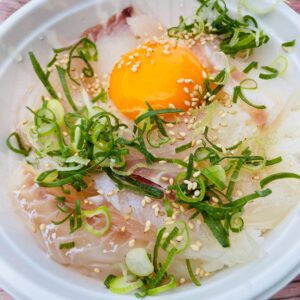
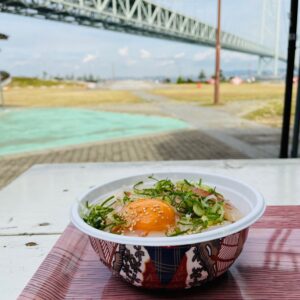
At “Takoiso”, I ate a Tamagoyaki of octopus and conger eel (15 pieces for Yen1,100). the Ministry of Agriculture, Forestry and Fisheries has selected Akashiyaki (Tamagoyaki) as a “Local dishes loved by the nation” in Hyogo Prefecture. I could feel the taste of octopus and conger eel well, and it was very delicious.

I had sashimi of “Akashi’s specialty three kinds (sea bream, octopus, and conger eel)” and steamed conger eel at “Akashi-tei Uo no Tana” in “Uo no Tana Shopping Street”. “Three kinds of Akashi specialties” were all exquisite. Especially, the sea bream was delicious. I preferred steamed conger eels to sashimi. After all big conger eel is fatty and delicious. As I explained before, conger eels with a large size of 300g or more are called “Densuke Anago (conger eels)” in Hyogo prefecture.

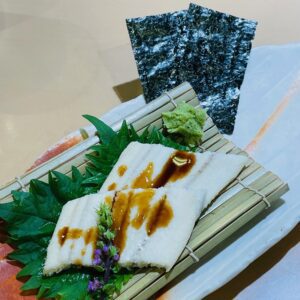
Important points
If you take a bus to Awaji Island, you will not be able to see the bridge because it will pass through the Akashi Kaikyo Bridge. We recommend using the Awaji Jenova Line, a ship that allows you to enjoy the bridge from above the sea, even if it is only one way.
The fare for the Awaji City community bus “Awajin Awahime Bus” is as high as Yen500 per ride. The one-day pass for unlimited rides is Yen1,000, so if you ride more than once, it is better to buy a one-day pass. A one-day pass can be purchased from the bus driver.
The bus stop of “Awaji”, the roadside station of “Awajin Awahime Bus”, is located along the road. There is also a free shuttle bus stop in the parking lot of the roadside station “Awaji”, which is confusing. I made a mistake. You should be careful.
Former Kinoshita House, Former Sanji Muto Residence, and Sun Yat-sen Memorial Hall have a common admission ticket for all three residences: Yen340 , which is a great deal.
Note: The departure / arrival times, fees, admission fees, etc. of transportation listed in the text are as of the time of writing the BLOG. They may change in the future, so please check for yourself when you go on a trip.